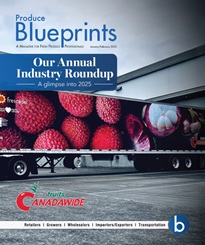As the summer season begins to wind down, the produce market reflects the changing weather and the evolving demands of consumers. Because the remnants of July’s warmth will likely linger long into September this year due to extreme weather patterns, the transition to fall may come with more volatility than usual.
This week, the ProduceIQ Index is shaped by a smaller-than-expected apple harvest, a surprising surge in potato prices, and ongoing challenges for tomato and strawberry growers due to extreme weather conditions across the country.
ProduceIQ Index: $1.19/pound, up +1.7 percentover prior week
Week #33, ending August 16th
Blue Book has teamed with ProduceIQ BB #:368175 to bring the ProduceIQ Index to its readers. The index provides a produce industry price benchmark using 40 top commodities to provide data for decision making.
As the back-to-school season ramps up, these developments will determine produce price trends for our 2024 fall season.
Mid-August feels like the end of a rollercoaster. The thrill of July lingers like a dream as the ride slows to an imminent halt. Everything about the summer season seems sweeter in the light that it will soon disappear, especially the berries.
Fortunately, with the advent of fall, fruit such as apples can begin to fill the holes in consumers’ appetites left by the delightful but fleeting peak summer varietals. Forecasts for 2024’s Gala, Ginger Gold, and Honeycrisp apple season are in, and this year’s crop is forecasted to be at least 10 percent smaller than last year’s record crop.
Storage crop from 2023’s record-breaking season keeps prices low despite mounting back-to-school demand. At $25, average prices are well below the norm for week #33 but will likely climb higher as summer melts away into the fall season.

Potatoes are having a wild week. Prices are up +41 percent after weeks of record low average prices. Russets are leading the epic comeback as supply constricts on larger-sized spuds. A gap in production is shaping up as Idaho finishes up its storage crop, and growers push back the harvest to give the new crop time to size up. Expect market volatility for at least two weeks.

Heat in the West and rain in the East continue challenging round tomato supply. Prices are up another +9 percent over the previous week to $27. Prices will likely continue to climb until the new crop can relieve heat-stricken Western markets in September. When possible, substitute with expensive but slightly more affordable plum-type tomatoes.
Strawberries are this week’s commodity to watch. A dark horse of sorts, prices are up +23 percent over the previous week. Western heat and back-to-school demand are pushing average week #33 prices to the second-highest point in the last ten years. A significant gap in supply may form over the next few weeks as production in the Salinas/Watsonville areas fades and growers in Santa Maria work to fill in the gaps.

Please visit our website to discover how our online tools can save time and expand your reach.
ProduceIQ is an online toolset designed to improve the produce trading process for buyers and suppliers. We save you time, expand your opportunities, and provide valuable information to increase your profits.
ProduceIQ Index
The ProduceIQ Index is the fresh produce industry’s only shipping point price index. It represents the industry-wide price per pound at the location of packing for domestic produce and at the port of U.S. entry for imported produce.
ProduceIQ uses 40 top commodities to represent the industry. The Index weights each commodity dynamically, by season, as a function of the weekly 5-year rolling average Sales. Sales are calculated using the USDA’s Agricultural Marketing Service for movement and price data. The Index serves as a fair benchmark for industry price performance.



